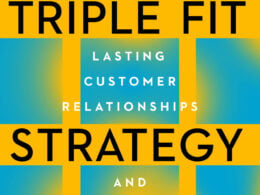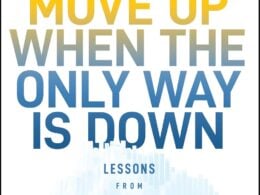The following is excerpted from “Ruthless Consistency: How Committed Leaders Execute Strategy, Implement Change, and Build Organizations That Win” by Michael Canic, p. 59-64 (McGraw Hill, September 2020).
StartupNation exclusive discounts and savings on Dell products and accessories: Learn more here
Our big audacious goal
When I was young and foolish, my buddy Ken and I decided to test our rock-climbing skills on Cascade Mountain in the Canadian Rockies. Having done almost no research, we arrived at the mountain, picked out a route that looked promising, and began to climb. Without ropes, of course.
It was all going well. Until it wasn’t. The climbing got increasingly difficult, and we soon realized we were at the limit of our abilities—and our risk tolerance. Just one problem: We now had to downclimb. Hmmm, hadn’t planned for that.
We quickly learned one of the fundamental truths of rock climbing: Climbing down is a lot harder than climbing up. At one point, still high on the rock face, Ken couldn’t find the next move down and his legs started shaking from fatigue. “I don’t think I can hang on,” he yelled, his voice cracking. This, at the exact moment I was 20 feet directly below him on the rock face. Which meant if he were to fall, he would crash into me and send us both plummeting off the mountain and into the obituaries section of the annual alpine journal.
Fortunately, Ken was able to steady himself and find the next move. With considerable anxiety, we continued, and finally were able to downclimb to the base. At which point, we noticed the memorial plaques bolted to the rock wall for climbers who had lost their lives there.
The point? We had a big, audacious goal. It’s easy to set a big, audacious goal. But if you’re not clear on the implications of pursuing it, then what you aspire to could destroy you.
You’d better understand why.
Related: This CEO Debunks the Myth of the Overnight Success
The three Rs: Rewards, risks and requirements
Dream big! Develop a vision! Follow your passion!
And why not? We’re continually inspired by stories of those who had big dreams and the motivation, courage, and persistence to fulfill them. The entrepreneurial spirit in all its glory!
Yet the more common stories, the ones you’re less likely to read about, are of those who pursued big dreams, and failed. You don’t see book titles trumpeting “Broken Dreams: How I Pursued My Passion, Failed Miserably, and Lost Everything.”
You’re not going to like what you’re about to read next, but it’s the truth.
An unfortunate consequence of the popular view that you should dream big and pursue your passion is that it implies any dream is worth pursuing.
It isn’t.
Not every dream is worth pursuing? Don’t pursue your passion? What kind of negative, self-defeating advice is that?
Stay with me. I’m not saying you shouldn’t dream big. I’m saying that before you commit to pursuing your dream, you need to understand the three Rs—rewards, risks, and requirements. Understanding these allows you to answer the question, “Is this a dream I am truly committed to pursuing or not?” There’s no wrong answer, as long as it’s an informed answer.
Once you conjure up your next big dream, ask yourself these questions:
- “Why that dream? Why not some other dream?”
- “What rewards make it uniquely worth pursuing?”
- “What risks and consequences are associated with pursuing it? Am I willing to accept them?”
- “What is required to fulfill the dream? Am I willing to meet those requirements?”
For some organizations, the dream is an arbitrary number: Grow to $100 million in sales within two years. OK, but why that number (other than the obvious reason that it’s a round number)? Why not $75 million? Why not $125 million? Why not $91.6 million? What rewards make that number uniquely worth pursuing? Is there anything of significance other than hitting a round number? Is that compelling in and of itself?
What risks are associated with growing to $100 million in sales within two years? Could growing quickly cause you to outstrip your infrastructure? Could your ability to deliver on time slip? Could your customer service suffer? Could decision-making get bogged down? How likely are those possibilities? What are the consequences, and are you willing to accept them? Could you and would you act to mitigate them?
What is required to fulfill the dream? Would it force you to make acquisitions? Would it mean taking on debt and increasing your exposure? Would it mean giving up equity? Are you willing to meet those requirements to realize the dream?
Some might say that asking questions like these can suck the heart and soul out of a dream, that subjecting our dreams to the filters of reason would result in many dreams never being pursued and many successes never being achieved. I would say that not asking these questions can result in you discovering too late that you’re climbing a mountain you don’t want to be on.
Sign Up: Receive the StartupNation newsletter!
Why do successful companies fail? Research suggests that two of the most common reasons are:
- They get caught up in the undisciplined pursuit of more, and
- They deny the risks and perils associated with their decisions. The first occurs when growth becomes the sole purpose of a business, instead of the outcome of a purposeful and well-designed business. The second occurs when leaders fall victim to the illusion of infallibility.
Knowing what you now know, are you comfortable with dreaming big and following your passion without asking yourself about rewards, risks, and requirements?
There’s nothing wrong with dreaming big, wanting to climb a rock wall, or becoming a $100 million company. Just make sure that the rewards are compelling, that you understand and are willing to accept the risks, and that you recognize and are willing to meet the requirements.
Don’t let reason dictate which dreams you pursue. But don’t pursue your dreams ignoring the voice of reason.
“Ruthless Consistency: How Committed Leaders Execute Strategy, Implement Change, and Build Organizations That Win” is available now wherever books are sold and can be purchased via StartupNation.com.






